Cork Electric Tramways
History
Cork's electric tramway was probably promoted by the British Thomson-Houston Company, a large electrical engineering concern based in Rugby, England, or by individuals with close links to it. The scheme, for a 2ft 11ins-gauge overhead electric tramway, had the blessing of Cork Corporation, an Order in Council (from the Privy Council of Ireland) being granted on the 6th July 1897. Agreement had clearly also been reached with the corporation to provide an electricity generation and distribution system, a company — the Cork Electric Tramways and Lighting Company — having been registered on the 18th June 1897 to build and operate both this and the tramway.
Construction probably started in 1898, BTHCo being heavily involved, along with the William Martin Murphy, a well-known Cork luminary who would eventually become chairman of the company, as well as several other tramways in Ireland. The unusual gauge was chosen to enable the running of railway stock (wagons) over the system, an eventuality that never came to pass. The system opened to the public on the 22nd December 1898 in truncated form, as the extremities of two of the lines (to Sundays Well and Blackrock) were within the boundary of Cork County Council, with whom the company had not yet reached agreement.
The Sundays Well line was fully opened in 1899, and the Blackrock line in 1901, which took the system to its final size of 9.89 miles. Centred on the Father Matthew statue in Patrick Street, lines radiated westwards along Western Road to Sundays Well; southeastwards along Douglas Road to Douglas; southeastwards then eastwards along Blackrock Road to Blackrock; eastwards along Lower Glanmire Road to Tivoli; and eastwards along Summer Hill to St Lukes Cross.
The system was operated by 35 tramcars, 18 delivered in 1898, 10 in 1900 and 7 in 1901. It was probably unique amongst tramways in the British Isles in sharing a road (Western Road) with passenger trains of the 3ft-gauge Cork and Muskerry Light Railway.
The tramway appears to have led a relatively untroubled existence until the 11th December 1920 when Tramcar No 3 was burnt out during a night of rioting against British rule.
Motor bus competition — in the form of Cork Motor Services — appeared on the streets on the 5th June 1926, the fray eventually being joined by a host of other operators, eventually including the Irish Omnibus Company. As a result, passengers deserted the trams in considerable numbers, the system making losses every year during the late 1920s. This situation was probably only sustainable through subsidy by the electricity supply side of the operation, the company clearly recognising which way the wind was blowing in the mid-to-late 1920s when it changed its name to the Cork Electric Supply Company.
A yet more ominous development for the tramway was the establishment of the state-owned Electricity Supply Board on the 11th August 1927. It was now only a matter of time before the electricity supply side of the CESCo would be sold to the ESB, leaving it with the loss-making tramway, which it would inevitably close. The electricity generation and supply assets of the CESCo were eventually acquired by the ESB (in April 1930), the company subsequently announcing that the tramway would close on the 31st March 1931.
Although the closure duly took place on the advertised date, the Irish Omnibus Company, which was meant to provide replacement bus services, was unable to supply enough vehicles to meet the demand. The precise arrangement between the CESCo and the IOCo is unclear, but the most likely scenario is that the former either handed over (or sold) the tramway to the latter, as Cork Corporation (and William Cosgrave, president of the Executive Council of Ireland) prevailed upon the IOCo to keep the trams running. The tramway was re-opened one week later (on the 7th April 1931), the IOCo operating it at a significant loss for a further six months, the IOC regarding this as the price of obtaining a monopoly on motorbus operation in the city.
The tramway was closed for a second and final time on the 30th September 1931.
Uniforms
Several photographs of the earliest days of the tramway have survived, and whilst some may be of proving runs before services proper began, the sheer number of them that show staff wearing informal attire, strongly suggests that uniforms had not been issued when services commenced, nor were they issued for a considerable period afterwards. Staff therefore wore smart but informal attire, comprising: jackets, shirts and ties, along with the fashionable headgear of the day, which around the turn of the century, was the flat cap and the bowler hat. This may in fact have been a deliberate policy of the CET&LCo, though why they would choose not to issue uniforms is unclear.
During the early Edwardian era, photographs clearly show staff wearing kepi-style caps, along with single-breasted jackets with lapels. Unfortunately, it is not possible to say from the surviving images what insignia, if any these garments carried, nor indeed, whether the jackets were informal or issued by the company. From around 1905, however, uniforms were definitely being worn; the jackets were single-breasted with five buttons, two breast pockets (with button closures) and stand-up collars. It is unclear what insignia the latter carried, though in later years they certainly bore a round badge with a border, in the centre of which were either system initials or an employee number. Caps were of the tensioned-crown peaked type; they bore a cap badge of some description, possible bearing the grade, but certainly not the classic metal, off-the-shelf, script-lettering 'Motorman' and 'Conductor' grade badges in widespread use elsewhere.
Tramcar crews were also issued with double-breasted greatcoats with high, fold-over collars; it is unclear whether these carried any insignia.
Photographs of senior staff are yet to come to light, so it is currently unclear what uniforms they wore.
Unlike the vast majority of tramway systems elsewhere in the British Isles, the CET&LCo appears not to have employed the services of women during the Great War, possibly because the loss of men to the armed services did not warrant it.
Further reading
For a history of Cork's tramways, see: 'Tram Tracks Through Cork' by Walter McGrath; Tower Books (1981).
Images
Motormen and conductors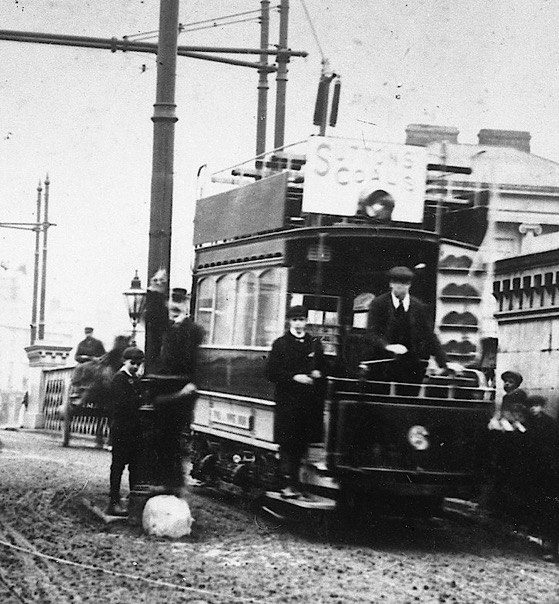
Although out of focus, this shot of Tramcar No 6, captured on Parnell Bridge, suggests that tramcar crews initially wore informal attire. The photo was purportedly taken in 1900, a full year after opening, though this seems open to question given the pristine condition of the vehicle. The image may therefore be of a proving run rather than a revenue-earning service. Photo courtesy of the National Tramway Museum. 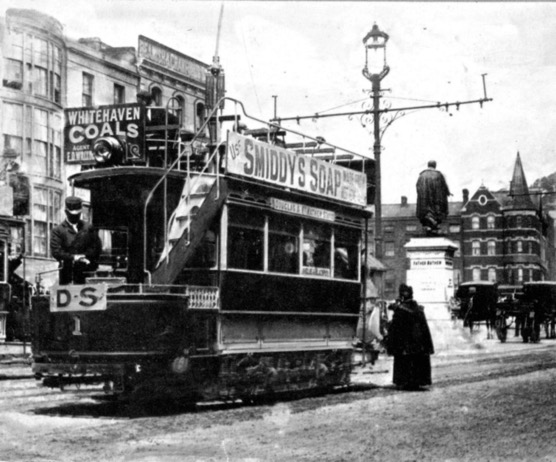
Tramcar No 1 stands in Patrick Street, with the Father Matthew statue in the background — photo undated, but given that the latter no longer has railings around it, probably taken in the early Edwardian era. 'D S' signifies that the tram is working a Douglas-Statue service. Photo believed to have been taken by Alec R Day, courtesy of Jim Kilroy, tram archivist at the National Transport Museum (see link).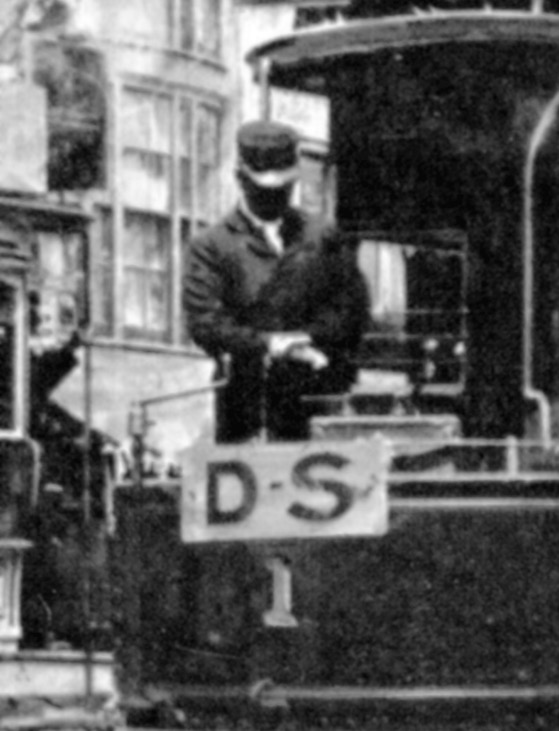
An enlargement of the above photograph showing the motorman, who is clearly wearing a kepi-style cap, and a jacket that would appear to have lapels, unlike subsequent jackets.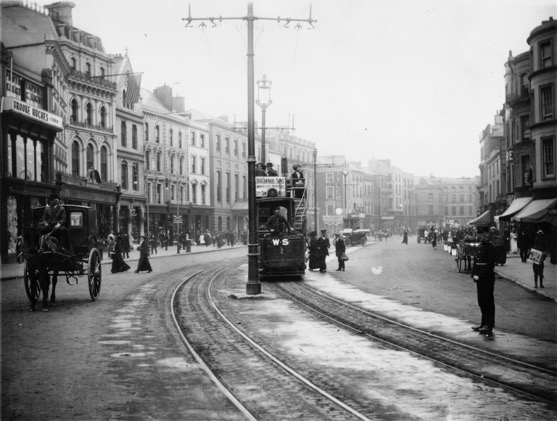
Tramcar No 1 on a Sundays Well-Summerhill service in Patrick Street — photo undated, but probably taken shortly before the Great War. Photo courtesy of the Tramways and Light Railway Society, with thanks to David Voice.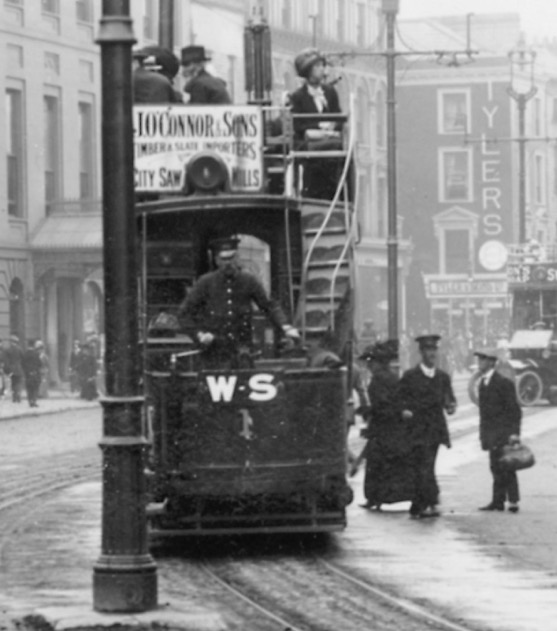
An enlargement of the above photograph showing the motorman, who is clearly wearing a single-breasted jacket and tensioned-crown peaked cap.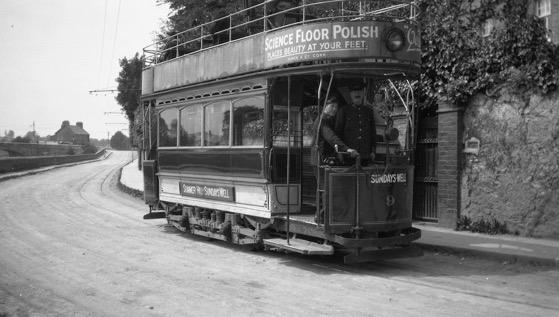
A shot of Tramcar No 9 taken on the 3rd September 1931 at St Sundays Well, barely four weeks before the system's final demise. Apart from the advertising enamels and the sagging platforms, the vehicle appears to be in relatively good condition. Photograph by Dr H Nicol, courtesy of the National Tramway Museum.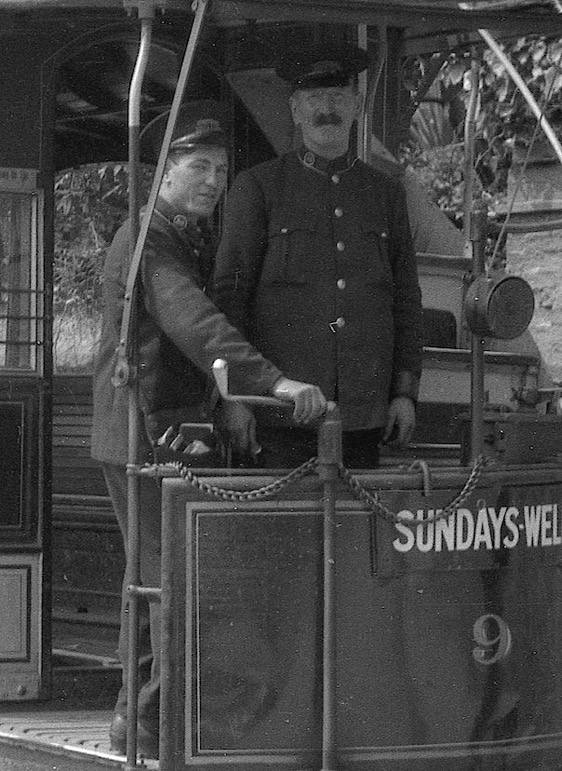
An enlargement of the above photograph showing the motorman and conductor, both evidently still proud of their jobs and their charge. Whilst it is possible that the crews are wearing uniforms of the Irish Omnibus Company, it seems inherently unlikely that the company would order new uniforms for the short period it operated the trams.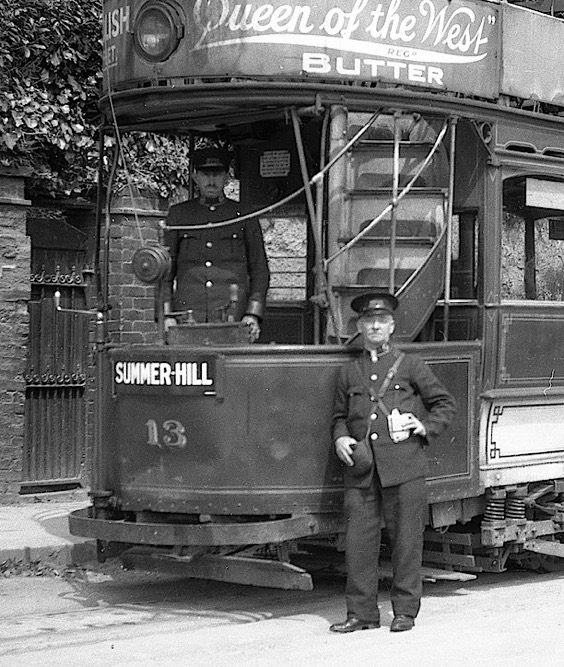
Another crew shot taken on the same day (3rd September 1931) and at the same location, but this time of Tramcar No 13. Photograph by Dr H Nicol, courtesy of the National Tramway Museum.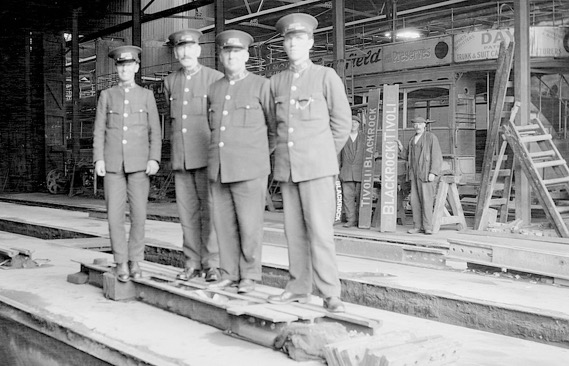
A rare study of four tramwaymen taken inside the depot, but one which is unfortunately out of focus. Photograph by Dr H Nicol (taken on the 3rd September 1931), courtesy of the National Tramway Museum.
Senior staff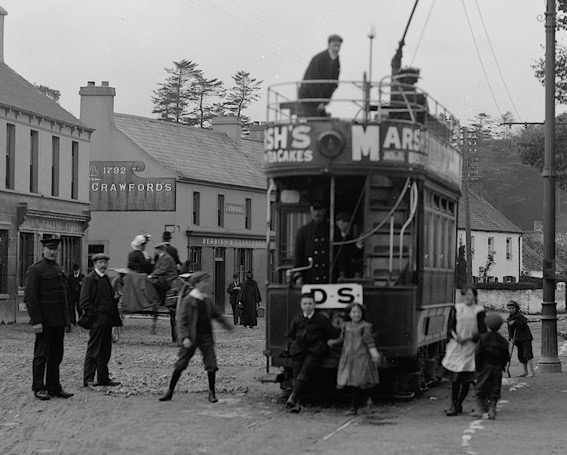
An animated street scene in Douglas village — photo undated, but probably mid-Edwardian. The figure on the left may well be a tramway inspector, though this is far from certain. Photo from the Fergus O'Connor Collection, courtesy of the National Library of Ireland.